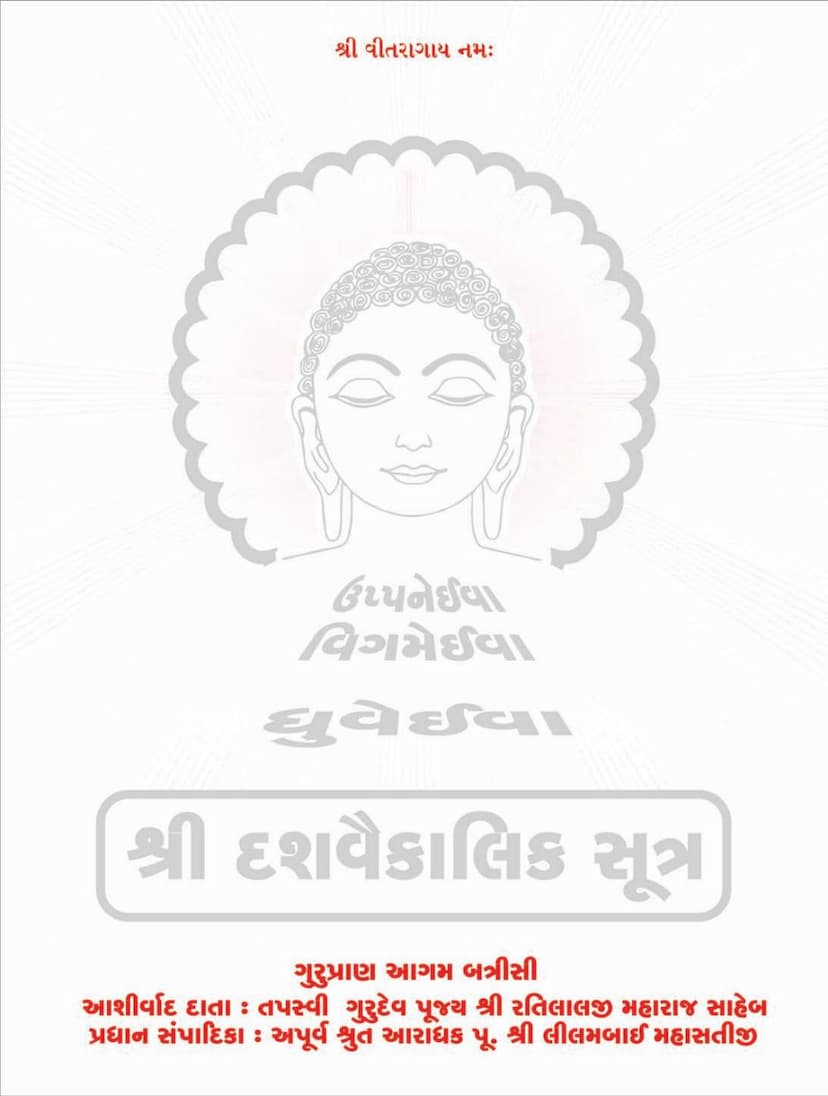Agam 29 Mool 02 Dasvaikalik Sutra Sthanakvasi
Added to library: September 1, 2025

Summary
Based on the provided text, here's a comprehensive summary of Agam 29, Mool 02, Dasvaikalik Sutra, focusing on its teachings:
The Dasvaikalik Sutra, presented by the publisher Guru Pran Prakashan, Mumbai, and authored by Gulabbai Mahasati, Artibai Mahasati, and Subodhikabai Mahasati, is a foundational Jain text from the Sthanakvasi tradition. It delves into the essence of Jain conduct, particularly for ascetics, offering practical guidance for spiritual advancement. The sutra is praised for its comprehensive yet concise exposition of core Jain principles.
The text is a compilation of teachings that aim to guide the seeker towards spiritual liberation. It emphasizes the importance of self-control (Sanyam), asceticism (Tapa), and non-violence (Ahimsa) as the cornerstones of the Dharma. The Dasvaikalik Sutra is considered a vital text for understanding the path of the ascetic, offering detailed instructions on various aspects of their conduct and inner disposition.
The text is structured into several sections, each addressing a specific area of spiritual practice. Key themes that emerge from the provided pages include:
-
The Nature of Dharma: The sutra begins by defining Dharma as encompassing Ahimsa (non-violence), Sanyam (self-restraint), and Tapa (asceticism). It highlights that even celestial beings venerate those who embody Dharma in their lives, emphasizing the supreme merit of this path.
-
Right Conduct and Discipline: A significant portion of the text is dedicated to outlining the ethical and disciplinary principles for ascetics. This includes:
- The Six Lifekayas (Chh Jivanikaya): The text meticulously describes the six types of living beings (earth-bodied, water-bodied, fire-bodied, air-bodied, vegetation-bodied, and mobile beings) and stresses the importance of extreme care and non-violence towards each of them. This is presented as the foundational aspect of righteous living.
- The Five Great Vows (Pancha Mahavratas): While not explicitly detailed in the provided excerpts, the emphasis on Ahimsa and Sanyam implies the strict adherence to these fundamental vows, which are central to Jain practice.
- The Importance of Minor Conduct (Shrut Kalika Achara): The sutra emphasizes that even seemingly minor actions and regulations are crucial for maintaining spiritual purity. It outlines numerous "Acharas" (rules of conduct) and "Anacharas" (prohibited actions) that ascetics must strictly follow. These cover a wide range of daily activities, from eating and drinking to speech and movement, ensuring that every action is performed with utmost mindfulness and non-violence.
- Pindesana (Alms-Seeking Conduct): A considerable focus is placed on the proper way of collecting alms, highlighting the need for discretion, non-violence in the process, and detachment from the food itself. It details how to approach homes, accept food, and the purity required in every step of this practice. The text stresses avoiding any act that might cause harm or distress to living beings, even the smallest ones.
- Speech and Communication (Suvakya Shuddhi): The sutra emphasizes the significance of right speech, detailing what to say and what not to say, even if the words are truthful. It highlights the importance of speech that is beneficial, gentle, and devoid of causing harm or irritation to others. The text outlines the nuances of polite and appropriate address.
- The Importance of Purity: The sutra details various forms of purity, including physical purity (avoiding impure water, contaminated food), mental purity (detachment from worldly desires), and verbal purity (avoiding harsh or hurtful speech).
-
The Role of the Guru: The text places a high value on the spiritual teacher (Guru). It stresses the importance of respecting and obeying the Guru's teachings and adhering to their guidance, highlighting the dire consequences of disrespect or neglect towards the Guru. The teachings suggest that the Guru's grace is instrumental in spiritual progress.
-
The Path to Liberation (Moksha): The ultimate goal of the Dasvaikalik Sutra is to guide the practitioner towards liberation from the cycle of birth and death. This is achieved through rigorous asceticism, unwavering adherence to Jain principles, and a deep understanding of the soul's true nature, leading to the eradication of karma and the attainment of the pure, liberated soul.
-
The Importance of Mindfulness and Vigilance: Throughout the text, there's a recurring emphasis on constant mindfulness and vigilance in every action. The ascetics are instructed to be aware of their conduct at all times, whether awake or asleep, alone or in a group, to avoid any transgression, however small.
The provided pages also reveal the reverence with which this text is treated. There are numerous acknowledgments and dedications to esteemed spiritual leaders and patrons, reflecting the importance of this work within the Jain tradition. The dedication to the memory of Gurudev Shri Pranalalji M. Sa. and the celebration of the diamond jubilee of Gurudev Shri Ratilalji M. Sa. during the publication further underscore the significance of this text and the lineage associated with its propagation. The commitment to making these ancient scriptures accessible through translation and publication is a testament to the ongoing efforts in Jain education and spiritual dissemination.
In essence, the Dasvaikalik Sutra is a profound guide for ascetics, illuminating the path of rigorous spiritual discipline, ethical conduct, and profound mindfulness, all directed towards the ultimate goal of liberation.